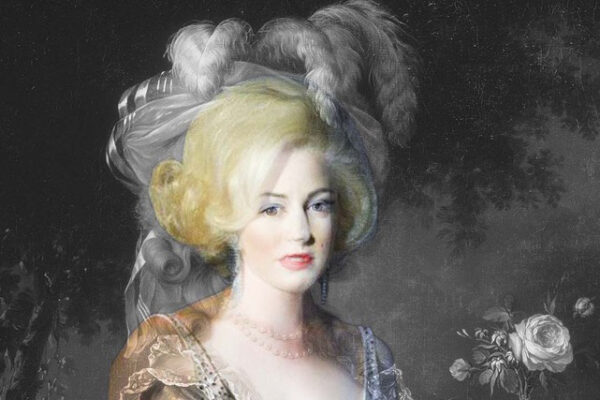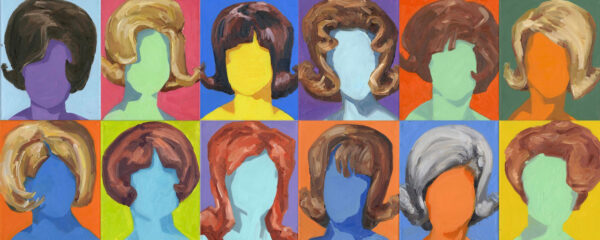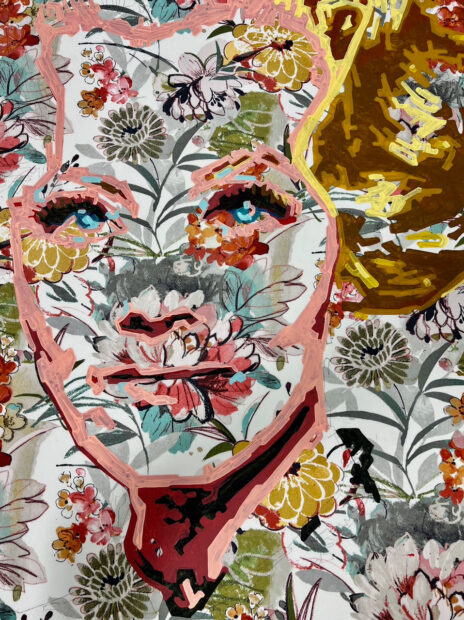Andy Warhol once said, “People sometimes say the way things happen in the movies is unreal, but actually, it’s the way things happen to you in life that’s unreal.” Stranger than fiction, for artist B Shawn Cox, comes in the form of bouffant hair. Not simply because it’s big, but because of everything the style signifies about human nature: our tendency to conform, our desire for acceptance, and the questions it asks about identity and recognition. Cox untangles this strange social and cultural phenomenon in his latest body of work, on view in BOUFF! The Big Tease at Davis Gallery in Austin.
During the late 1950s and early 1960s, around the same time Warhol was gaining popularity in the art world, the bouffant hairstyle had its hold on women’s heads across the country. The proliferation of mass media outlets during this time meant that popularized versions of perfection, of self-image, began to seep into and transform peoples’ understanding of themselves. For women, this meant emulating hairstyles popularized by celebrities, such as Dusty Springfield and First Ladies Jacqueline Kennedy and Lady Bird Johnson.
With its impressively puffy and smooth appearance, a bouffant updo is untouchable, until pulled back at the end of the day to reveal a delicate and ratty underside. To construct the hairstyle, unteased hair is lightly combed over a teased pile to create a sleek illusion of volume. Of course, generous amounts of hairspray and pins are needed to stiffen and hold the hair in place, and a brush, introduced after the bouffant’s sculpting, would destroy its appearance. Cox remembers his mother telling him that when sporting the hairstyle, “the worst thing was going to PE, because you might sweat and ruin your hair.”
Flipping Fabulous, one of Cox’s digital collages on display at the gallery, speaks to the origin and evolution of the bouffant. Here, a black and white portrait of Marie Antoinette is blended with a similar, color image of a woman from the 1960s, creating a blurry, ghoulish, time-warped figure. Cox references Antoinette because she was one of the first women to make the pouf hairstyle popular in 18th century France. Centuries later, big hair still equates to beauty for women, although it is today sported with a little less ornamentation.
Cox explains that the bouffant is art in and of itself — a sculptural form made of hair — which he thinks is a little morbid in its own way. Emphasizing its ridiculousness, Cox says the hairdo is “a sculpture that people wear on their head and walk around with. And it’s socially acceptable. Everyone else is doing it.”
Taking high school yearbooks from the late 1960s as reference points, Cox created 12 Anonymous Bouffants, which depicts 12 faceless figures, each sporting similar versions of the pouf. While the figures are technically genderless and raceless, due to their lack of identifying characteristics (save for the hair), the grid is uncanny. It emanates an overwhelming feeling of anonymous, strait-laced postwar hegemony, which steamrolled everything in its path. When you put brightly colored figures in a grid, there is an inevitable Warhol comparison to be made. Here, Cox is playing into the trope, while also finding a different way to critique the culture — creating a sort of Thirteen Most Wanted Men, but for hairdos.
Cox’s work is layered, and not just materially. Electric Blu combines multiple sheets of brightly colored stencils to create the “ideal” face of a 1960s woman. The negative spaces of each template expose the next colorful layer underneath, working together to coalesce into a combined whole. These material layers soak through and become commentary on the fabric of our society; here, the woman’s face, made up of fluorescent oranges and pinks, is more harsh and ghastly than enchanting.
Norms instilled in Cox growing up in West Texas, which in some ways his own parents represented, play into what the artist calls “Texas’ collective social mythology.” Cox says his parents “were high school sweethearts,” and that their childhood yearbooks were among those culled for bouffant specimens. His family exemplified a Texan stereotype: “In particular, my dad was very much in the cowboy category, and my mom was in her own way a beauty queen.”
Interestingly, while touting a rugged individualism, Texas, at times, does like to be on-trend. The template nature of Electric Blu speaks to the conformity that bouffant hair achieved across the U.S., from Boston socialites to Odessa oil baronesses. From his research through the high school annuals, Cox notes there are about five pervasive versions of the same bouffant hairstyle. “Its like they were cranking them out,” he says.
The idea of repeated uniformity appeals to some artists, but not to Cox. He emphasizes that everything a person is — the makeup of one’s values and beliefs — cannot be molded to fit into any one particular style or category.
Even with his individualism-forward ideas, Cox is well aware of the restricted frameworks in which gender has traditionally functioned. He says his painting Floral Aqua-net plays with the stereotypes of femininity and masculinity, as it depicts a strong angular face with short, wispy blonde hair, painted atop floral fabric. By sharply contrasting hard, linear graphic elements with a floral background, the figure’s gender loses its signifiers. The work combines and confuses physical stereotypes in an attempt to take aim at larger perceptions: women have big hair, men have short hair; women are delicate and nurturing, men are strong breadwinners.
Cox is all for shaking up preconceptions. He explains his repurposing of nostalgic icons, saying, “I think it’s an indication of standardized roles in society. Groups like the drag community exaggerate icons from the past. I think it’s a fascinating transition into a different culture, far from what the icons were originally and how they were originally imposed on a society.”
According to Cox, his art pulses in a pop vein with its playful, but subversive approach. Thinking about his work in relation to the legacy of Warhol in particular, Cox says, “I love the commercial advertising aspect of trying to catch somebody’s attention and resonate with something that resonates with them.”
Something about neon-colored, faceless figures is relatable. Perhaps it is how alien they are — so, in fact, they’re not accessible at all on a personal level, but instead are a spectacle, understandable to everyone because they’re relatable to no one; a backdrop. Cox has used these brightly colored nothings as mannequins — a smart ploy because they scream “look here,” and then ultimately leave us staring at his real subjects: masses of hair which are individual, but all the same. As far as the absurdity of the bouffant and how it has reinforced our cultural understandings of beauty, femininity, and heterosexuality, Cox sums up his take on it, saying: “it makes no sense at all.”
B Shawn Cox: BOUFF! The Big Tease is on view at Davis Gallery in Austin, Texas from January 14 – February 25, 2023. An opening reception for the show will be held on January 14 from 4-7 PM.








